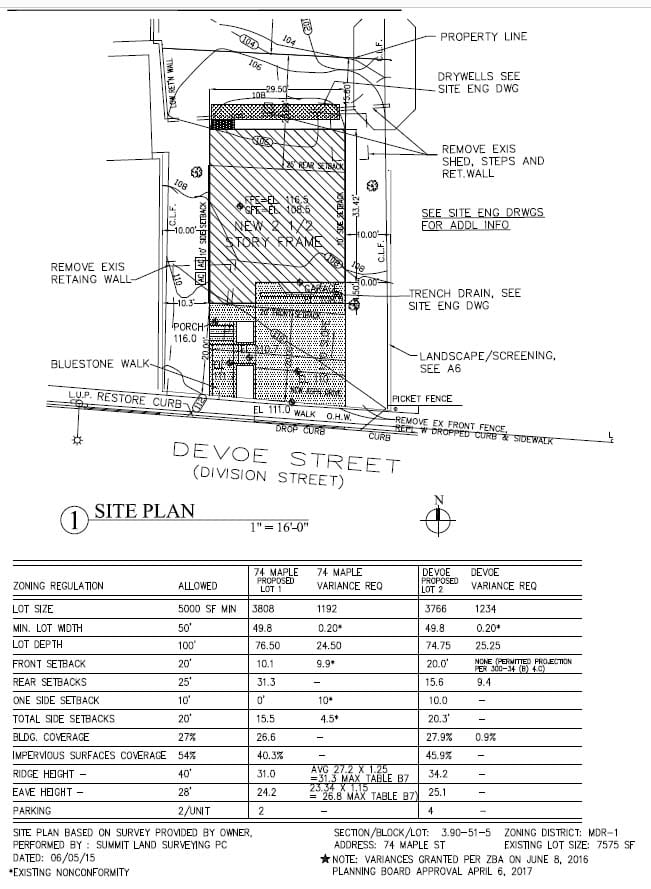Intro & definition
Understanding Zoning variances in the construction and real estate world pertain to permission to go beyond the allowable zoning and land-use rules. Since our office is located in Westchester County, a densely populated suburban area that has little open-buildable area, we frequently encounter situations where we must seek relief from many of these rules.
Many of the nearby towns predate zoning and land use laws. So take those factors and add to that, the need to change and reconfigure houses, buildings and property to meet modern demands- and you have a frequent situation where current rules can be too restrictive. On the other side of the coin, owner often seek too much relief (read greedy over-sized McMansion) from the rules and need to be slapped back into conformance with the rules. 
The diagram above, shows some of the most basic rules that almost all properties have to comply with: setbacks or yard requirements. For example the plan and chart are common means of illustration for number of feet back that the structure needs to be away from the property line- the number will change form neighborhood to neighborhood depending on density, location, transportation features etc.. These rules govern the placement of the structure with respect to the property lines- partly for health, privacy, fire safety reasons. Of course not every lot is shaped like this and there are numerous reason why a building or proposed addition may not be able to meet the criteria.
Process
To begin the process of obtaining a variance, an application usually has to be submitted to the municipality outlining the basic intention of the project usually in the form of drawings, issuance of public notices and various forms. The regulations that will be adhered to and not adhered will be identified and documented by the municipality (a building department, zoning board or similar agency) The project usually will need a letter or similar document from the municipality denying the application on the grounds that certain aspects of the zoning regulations will not be met. This is called a “denial letter“. This denial letter that is often issued by the Building Department or Zoning officer is important, because it enables one to go to an agency such as the Zoning Board of Appeals to overturn (appeal) that decision- if the Zoning Board of Appeals believes that you a compelling case. This board is actually an appellate court.
This board is actually an appellate court.
What is a good case? Hardship? Precedent? It depends. There is usually a municipal board that listens carefully, reviews the findings and renders a decision. They are careful and try to weigh all the sides of the decision, as many people and large sums of money may be involved. They also want to be careful not to set a future precedent that can be used against their future cases. Occasionally, more information or investigation may be needed or additional input from other municipal boards like wetlands, planning or commerce may be requested. There are usually 5 “balancing points” that have to be addressed when weighing the benefit to applicant vs detriment to the neighborhood:
1.Undesirable change to the neighborhood or detriment to adjacent property?
2. Is the project achievable by other feasible alternatives?
3. Will there be an adverse impact on the environmental / physical nature neighborhood?
4. Is this a substantial variance?
5. Is this a self-created hardship?
Consequences
There can be lots of grey area in these questions and lots of bargaining that ensues stemming from these answers. Some projects take multiple meetings until all the information is vetted out and a verdict can be established. The meetings are generally public and often attended by concerned neighbors who could be affected by the project. Do your homework and try to find out their sentiments before the meeting, rather than a public pillory. Get support from your neighbors-written letters, face-to-face testimonials, similar precedents all help bolster you case.
Sometimes you have to go back to the drawing board and re-tool. Revise and Resubmit. Not always fun- but we all want to get to point B!
We’ve done plenty of variance work, and would love to answer any questions you might have. Call us now at 914 674 2950. We also work side by side with highly qualified land-use attorneys and would be happy to put you in touch.




